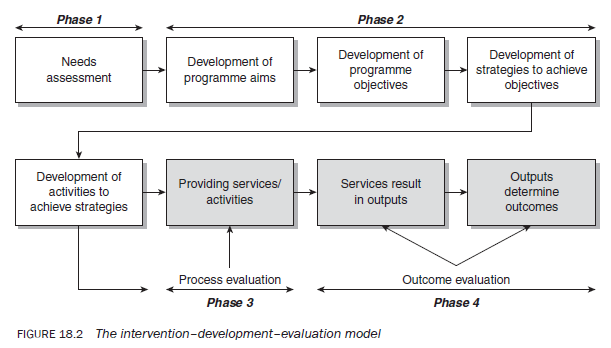To understand the evaluation process for an intervention, it is important that you also know how it is linked to the development of an intervention. The intervention-development— evaluation process is divided into four phases (Figure 18.2):
- needs assessment;
- intervention/programme development;
- intervention/programme execution;
- intervention/programme evaluation.

The development of an intervention usually starts with an assessment of the needs of a community, group or people living in a geographical area (phase 1). Based upon the needs, the aims and objectives for a programme are developed to meet these needs, which in turn become the basis of developing a conceptual intervention programme. This conceptual construction is primarily based on previous experiences, understanding of the problem area, knowledge about how others have dealt with the problem in other places and/or opinion of experts in the area. In the development of this conceptual model, particular attention is given to the formulation of strategies to achieve the objectives of the programme. Next, the precise activities needed to achieve these strategies are identified. Procedures for undertaking these activities are then drawn up. These activities and procedures constitute the contents of a programme (phase 2). Of course, they may need to be streamlined, modified or otherwise changed in the light of experience. Sometimes, a conceptual-intervention model is first ‘tested’ out as a feasibility study to identify problems and modifications before launching on a full scale. Having fine-tuned the intervention contents, it is executed in accordance with the proposed plan (phase 3). Services/activities constitute programme inputs, which result in intervention outputs, which in turn produce outcomes/impacts. Outputs are the direct products of a programme’s activities and are usually measured in terms of volume of tasks accomplished. Outcomes are benefits or changes in individuals or populations that can be attributed to the inputs of a programme. They may manifest as cognitive and/or non-cognitive changes. These may relate to values, attitudes, knowledge, behaviour, change in a situation or any other aspect that came about in an individual following the introduction of a programme. Though some evaluations are focused on the process by which a service is delivered (phase 3), the majority of evaluations are around either outputs or outcomes (phase 4).
Let us take an example: random breath testing (RBT). In RBT the outputs include the number of people tested; the number of awareness campaigns organised; the number of newspaper and television advertisements placed; the number of community forums held; and the number of police officers employed for the task of breath testing. The desired outcomes — the changes sought in people’s behaviour and the situation — may include a reduction in alcohol- related road accidents and deaths, and a reduction in the number of people caught driving under the influence of alcohol.
Let us take another example: the counselling service for couples with marital problems. In this example the outputs are the number of sessions with couples and the number of couples seen. The outcomes might be a reduction in the conflicts; greater marital stability with a beneficial effect on the couple’s children; a positive effect on work, productivity and income; increased satisfaction with life in general; or smooth separation by the couple from each other.
Source: Kumar Ranjit (2012), Research methodology: a step-by-step guide for beginners, SAGE Publications Ltd; Third edition.

you are truly a good webmaster. The web site loading velocity is amazing. It kind of feels that you are doing any unique trick. Moreover, The contents are masterpiece. you have performed a great job on this matter!